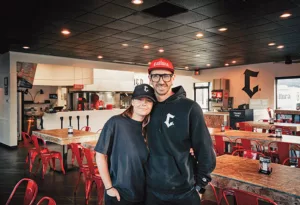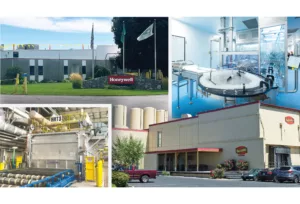
Spokane opens door to more backyard homes
City to adopt statewide ADU laws, loosen rules

The city of Spokane is preparing to adopt changes to its housing code regarding the construction of accessory dwelling units.
| Brio Tiny HomesSpokane’s urban landscape could soon see more in-law suites and backyard homes as the city gets ready to update its housing code to comply with the state's accessory dwelling unit laws and help ease the region’s housing crunch.
City of Spokane Planning Director Spencer Gardner says that to comply with the state's rules, the city must allow at least two ADUs on a residential property. The city also has to increase the maximum floor area for attached and detached ADUs to 1,000 square feet, up from its current 975-square-foot cap.
Sometimes referred to as a mother-in-law suite, backyard home, or alley house, an ADU is a separate self-contained living unit that is attached or detached from the primary residential unit on a single-family lot.
“What we’re hearing pretty clearly from the Legislature is that we need to loosen some of the constraints on building housing,” Gardner says. “And if there are situations where it works, we need to make sure that people can build the housing that we need.”
In 2023, the Washington State Legislature passed a bill that requires fully-planning cities and counties to allow two ADUs on all residential lots that allow single-family homes within an urban growth area. The deadline for cities and counties to implement these changes to their housing code is 2027, he adds.
Initial Spokane Plan Commission workshops were held in March and April to introduce the proposed amendments. A public hearing will be held in mid-May and the City Council is expected to take action next month.
The proposed amendments to the housing code are being applauded by some builders and consultants in the industry.
Rob Wuls, co-founder of Spokane-based Brio Tiny Homes, which specializes in designing and building ADUs, says he’s noticed more demand and growing interest from the public for ADUs.
Last year, the company completed six ADU’s throughout Spokane and North Idaho. This year, he expects to start on over 20 projects in the region.
“Growth has been steady,” he says. “There is no shortage of people calling.”
Joel White, executive officer at the Spokane Home Builders Association, says he’s supportive of all the work the city is doing to increase building in the region.
“These are all positive growth changes,” White says.
He cautions, however, that building an ADU requires due diligence from homeowners and investors.
“It still needs to meet all the building requirements," White says. "And Washington state has a very aggressive building code.”
As previously reported by the Journal, the city of Spokane amended the city’s housing code in 2022 to loosen restrictions on the construction of ADUs on properties with single-family homes.
Gardner says the main components of the adopted changes to ADUs in 2022 included increasing the allowable size; removing some of the requirements associated with design, such as matching windows and roof lines with the existing home; and removing the requirement that the owner of the home needs to live on site to build an ADU.
Since the city made its initial changes to the code in 2022, Gardner estimates the number of permits for ADUs has gone from hovering in the teens to averaging about 30 or more a year.
The city issued 29 ADU permits in 2024 and in 2023. In 2022, 39 ADU permits were issued, up from 21 in 2021 and 13 in 2020.
“The numbers fluctuate, but a simple way to put it is we’ve effectively doubled the amount of ADUs being built in the city from pre-code to post-code changes,” Gardner says.
While the upcoming changes to the code will likely increase the number of ADU builds, there are still other parts of the code that need to be adhered to and a few obstacles for owners to consider, Gardner says. Currently, many people reach out and show interest, but as they begin to research, there is a significant drop in people who actually move forward with a project, he says.
“Just because one part of the code says you can build something, it doesn’t mean that the code as an entire package says you can build it,” Gardner says. “It’s increasing flexibility, but we are still protecting what our code is designed to protect, like storm water and environmental concerns.”
The city, for example, limits how much a certain property can be covered with impervious surfaces, which refers to any surface that prevents rainwater from soaking into the ground, such as rooftops, driveways, and paved areas. Impervious areas can cause rainwater or stormwater issues elsewhere in the system, he explains.
Another barrier to building ADUs that Gardner has noticed includes the requirement for owners who are building on an unpaved alley to pave the alleyway. However, the state's ADU bill requires cities to exempt ADUs from those kinds of requirements that are typically required of larger-scale developments, he says.
“We’re hoping that’s a barrier that is reduced by these changes and that could result in some of those people who dropped off once they came into challenges, maybe rekindling their interest in looking at an accessory dwelling unit,” says Gardner.
Financing an ADU is another barrier that still persists, he says. While the finance world has made a lot of improvements over the last couple of years as ADUs have become more popular, there are still limited loan products for ADUs, he says.
Wuls, of Brio Tiny Homes, says that a 1,000-square-foot ADU will typically cost somewhere in the low $200,000s range. Smaller ADUs from 300 square feet to 700 square feet range from about $115,000 to $175,000.
Wuls says he and his partner, entrepreneur Matt Goodwin, design custom floor plans for their customers and build the ADUs on site. They work with municipalities on the particulars of the project, as well as local utility companies to connect power and sewer lines and submit for permitting. Not counting time to receive permits, the process from start to finish takes about four months, he says. The aim is to deliver a turn-key unit, he says.
Overall, Gardner says the upward tick in permitting is a positive sign that the city is working in the right direction.
“And we’ve seen increasing interest in what we call middle housing; town homes and duplexes,” he says. “And that’s a direct result of some of the code changes we’ve made around middle housing. We’re seeing an impact. We’re also seeing areas where we need to continue to improve.”




_web.webp?t=1764835652)